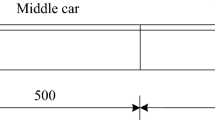Abstract
In this study, experiments were carried out to investigate aerodynamic characteristics of a high-speed train on viaducts in turbulent crosswinds using a 1:25 scaled sectional model wind-tunnel testing. Pressure measurements of two typical sections, one train-head section and one train-body section, at the windward and leeward tracks were conducted under the smooth and turbulence flows with wind attack angles between −6° and 6°, and the corresponding aerodynamic force coefficients were also calculated using the integral method. The experimental results indicate that the track position affects the mean aerodynamic characteristics of the vehicle, especially for the train-body section. The fluctuating pressure coefficients at the leeward track are more significantly affected by the bridge interference compared to those at the windward track. The effect of turbulence on the train-head section is less than that on the train-body section. Additionally, the mean aerodynamic force coefficients are almost negatively correlated to wind attack angles, which is more prominent for vehicles at the leeward track. Moreover, the lateral force plays a critical role in determining the corresponding overturning moment, especially on the train-body section.
摘要
基于缩尺比为1:25 的节段模型风洞试验,对湍流横风中高架桥上高速列车的气动特性进行研究。 在均匀流和湍流条件下,对−6°至6°风攻角范围内迎风和背风轨道上的典型车头和车身断面进行测压 试验,并采用积分法计算相应的气动力系数。实验结果表明,轨道位置对高速列车的平均气动特性有 影响,特别是对车身断面的平均气动特性。与迎风轨道处相比,背风轨道处的脉动压力受桥梁干扰影 响明显。湍流对车头断面的影响小于其对车身断面的影响。列车车头平均气动力系数与风攻角几乎呈 负相关,背风轨道上的车头断面尤其如此。此外,侧向力在决定相应的列车头车倾覆力矩时起着关键 作用,尤其是对车身截面。
Similar content being viewed by others
References
YAN Bin, DAI Gong-lian, HU Nan. Recent development of design and construction of short span high-speed railway bridges in China [J]. Engineering Structures, 2015, 100: 701–717. DOI: https://doi.org/10.1016/j.engstruct.2015.06.050.
HE Xu-hui, ZOU Yun-feng, WANG Han-feng, HAN Yan, SHI Kang. Aerodynamic characteristics of a trailing rail vehicles on viaduct based on still wind tunnel experiments [J]. Journal of Wind Engineering and Industrial Aerodynamics, 2014, 135: 22–33. DOI: https://doi.org/10.1016/j.jweia.2014.10.004.
NIU Ji-qiang, ZHOU Dan, LIANG Xi-feng. Experimental research on the aerodynamic characteristics of a high-speed train under different turbulence conditions [J]. Experimental Thermal and Fluid Science, 2017, 80: 117–125. DOI: https://doi.org/10.1016/j.expthermflusci.2016.08.014.
European Committee for Standardization. EN 14067-6:2018 railway applications-aerodynamics-Part 6: Requirements and test procedures for cross wind assessment [S]. Brussels, Belgium: CEN, 2018.
SCHROCK D, WIDDECKE N, WIEDEMANN J. The effect of high turbulence intensities on surface pressure fluctuations and wake structures of a vehicle model [J]. SAE International Journal of Passenger Cars Mechanical Systems, 2009, 2(1): 98–110. DOI: https://doi.org/10.4271/2009-01-0001.
BOCCIOLONE M, CHELI F, CORRADI R, MUGGIASCA S, TOMASINI G. Crosswind action on rail vehicles: Wind tunnel experimental analyses [J]. Journal of Wind Engineering and Industrial Aerodynamics, 2008, 96(5): 584–610. DOI: https://doi.org/10.1016/j.jweia.2008.02.030.
CHELI F, GIAPPINO S, ROSA L, TOMASINI G, VILLANI M. Experimental study on the aerodynamic forces on railway vehicles in presence of turbulence [J]. Journal of Wind Engineering and Industrial Aerodynamics, 2013, 123: 311–316. DOI: https://doi.org/10.1016/j.jweia.2013.09.013.
MA Cun-ming, DUAN Qing-song, LI Qiu-sheng, CHEN Ke-jian, LIAO Hai-li. Buffeting forces on static trains on a truss girder in turbulent crosswinds [J]. Journal of Bridge Engineering, 2018, 23(11): 04018086. DOI: https://doi.org/10.1061/(ASCE)BE.1943-5592.0001305.
Ministry of Transportation and Communication of PRC. JTG/T 3360-01-2018: Wind-resistant design specification for highway bridges [S]. Beijing, China: China Communications Press Co., Ltd., 2018. (in Chinese)
von KARMAN T. Progress in the statistical theory of turbulence [J]. Proceedings of the National Academy of Sciences of the United States of America, 1948, 34: 530–539. DOI: https://doi.org/10.1073/pnas.34.11.530.
SIMIU E, YEO D H. Wind effects on structures: modern structural design for winds [M]. 4th ed. New York, USA: John Wiley & Sons, Inc., 2019. DOI: https://doi.org/10.1002/9781119375890.
DORIGATTI F, STERLING M, BAKER C J, QUINN A D. Crosswind effects on the stability of a model passenger train—A comparison of static and moving experiments [J]. Journal of Wind Engineering and Industrial Aerodynamics, 2015, 138: 36–51. DOI: https://doi.org/10.1016/j.jweia.2014.11.009.
BAKER C J. Train aerodynamic forces and moments from moving model experiments [J]. Journal of Wind Engineering and Industrial Aerodynamics, 1986, 24(3): 227–251. DOI: https://doi.org/10.1016/0167-6105(86)90024-3.
BERGH H, TIJDEMAN H. Theoretical and experimental results for the dynamic response of pressure measuring systems [R]. Amsterdam, Netherlands: Nationaal Lucht-en Ruimtevaartlaboratorium, 1965. http://refhub.elsevier.com/S0167-6105(16)30020-4/sbref2.
YAN Lei, ZHU Le-dong, FLAY R G J. Span-wise correlation of wind-induced fluctuating forces on a motionless flat-box bridge deck [J]. Journal of Wind Engineering and Industrial Aerodynamics, 2016, 156: 115–128. DOI: https://doi.org/10.1016/j.jweia.2016.07.004.
TAMURA T, ONO Y. LES analysis on aeroelastic instability of prisms in turbulent flow [J]. Journal of Wind Engineering and Industrial Aerodynamics, 2003, 91: 1872–1846. DOI: https://doi.org/10.1016/j.jweia.2003.09.032
Author information
Authors and Affiliations
Corresponding author
Additional information
Foundation item: Projects(51808563, 51925808) supported by the National Natural Science Foundation of China; Project(KLWRTBMC18-03) supported by the Open Research Fund of the Key Laboratory of Wind Resistance Technology of Bridges of China; Project(2017YFB1201204) supported by the National Key R & D Program of China
Rights and permissions
About this article
Cite this article
He, Xh., Zuo, Th., Zou, Yf. et al. Experimental study on aerodynamic characteristics of a high-speed train on viaducts in turbulent crosswinds. J. Cent. South Univ. 27, 2465–2478 (2020). https://doi.org/10.1007/s11771-020-4462-3
Received:
Accepted:
Published:
Issue Date:
DOI: https://doi.org/10.1007/s11771-020-4462-3
Key words
- high-speed train
- viaducts
- aerodynamic characteristics
- turbulent crosswinds
- wind attack angle
- train section shape
- track position
- pressure measurement




